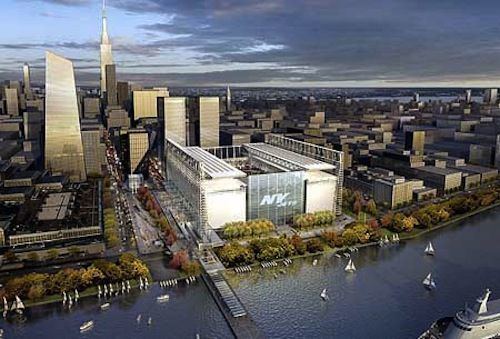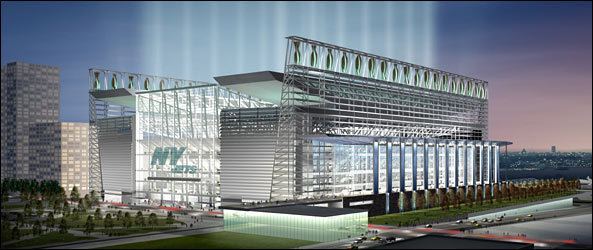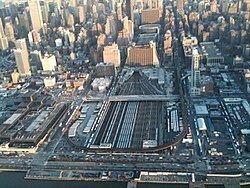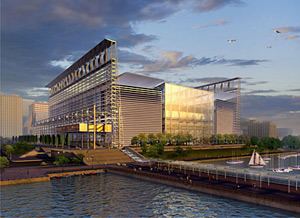 | ||
West side stadium
The West Side Stadium (also known as the New York Sports and Convention Center) was a proposed football and Olympic stadium to be built on a platform over the rail yards on the West Side of Manhattan in New York City.
Contents
- West side stadium
- Aps west side stadium delayed
- Public funds
- Bidding
- Mixed opinion
- Television ads
- Politics
- Olympic decision
- Aftermath
- References

The stadium would have been an all-weather facility with a retractable roof, allowing it to be used as either a 200,000 square feet (18,600 m2) indoor convention hall, or an 85,000 seat (75,000 post-Olympics) indoor/outdoor sporting event stadium. It was to be the new home for the New York Jets of the National Football League, who at the time of the proposal played at Giants Stadium in East Rutherford, New Jersey and were junior tenants to the New York Giants. The stadium was to have served as the centerpiece of New York's bid for the 2012 Summer Olympics, but, after heated debate, the proposal was defeated a month before the International Olympic Committee was to make its decision.

In the football off-season the building would have been used as an adjunct to the Jacob K. Javits Convention Center for conventions and as a replacement for Madison Square Garden. It was promoted by New York Governor George Pataki, New York City Mayor Michael Bloomberg, and Congressman Charles Rangel, but opposed by most of the local elected officials representing the area. The centerpiece of the city's bid for the 2012 Summer Olympics, the stadium would have been part of a larger project to revitalize a long-underdeveloped area, including expansions of the Javits Center and the New York City Subway's 7 service. It was going to host Super Bowl XLIV in 2010 along with a college bowl game with a Big East team to be known as the Big Apple Bowl.

Aps west side stadium delayed
Public funds

The stadium proved highly controversial because it would have been a major construction project requiring public financing. Though many of its opponents supported the larger West Side development program, they questioned the economic benefit of a stadium which would have spent much of its time unused, as well as the general premise of subsidizing a football team which generates hundreds of millions of dollars in revenue for a private owner. Opponents felt that the budget could be better spent on mixed-use facilities. Supporters of the stadium said the cost to the city (over $1 billion) was an investment and would create thousands of jobs and billions in commercial revenue for the area, perhaps leading to increased tax revenue that could be used for vital infrastructure.
Bidding

The rail yards were owned by the Metropolitan Transportation Authority (MTA), which originally negotiated privately with the Jets without seeking other possible buyers. After Cablevision presented a rival proposal for West Side development without a stadium, public sentiment against an apparent no-bid contract for the Jets prompted the MTA to establish an open bidding process for the site. There were three bids, from the Jets, from Cablevision and from Transgas, a power company. On March 31, 2005, the MTA board voted to accept the bid from the Jets, even though the Cablevision offer included more cash up front. Attorneys for Cablevision announced that they would file suit to challenge the decision, and many other media outlets lambasted the MTA's decision as simply doing Governor Pataki's bidding rather than accepting a plan that would best serve the public.
Mixed opinion

Public opinion was mixed. Some citizens of New York and New Jersey were in favor of the stadium because they wanted the 2012 Summer Olympics to be held in New York City. In order to host the Olympics, cities typically must build modern stadiums and prove to the International Olympic Committee that they have the resources to support the event.
Many Manhattan and West Side residents did not want the inconvenience, traffic congestion and resource drain that they believed the Olympics would bring to the already overcrowded city. The New York Daily News reported that 59% of New Yorkers were not in favor of holding the Olympics in New York at all. In December 2004, the commuter advocacy groups Straphangers Campaign and Tri-State Transportation Campaign filed a lawsuit which challenged the city's estimate that 70% of stadium patrons would use mass transit or arrive on foot instead of driving. Many Jets fans wanted the stadium built, no matter what the cost.
The stadium was also notably opposed by Cablevision, the sixth-largest cable television company in the United States and the then-owner of Madison Square Garden (MSG)—home to the New York Knicks and New York Rangers—and the MSG Network, which broadcasts most of those teams' games. Although MSG was initially a prospective partner in the project, they eventually concluded that the design was unworkable for their needs. After MSG dropped out, the City and State decided to go ahead anyway. The decision to place a new sports and concert venue in such close proximity to MSG, where it would hamper the older venue's ability to secure concerts and other events, forced Cablevision to oppose the plan. Cablevision went all out with an expensive advertising campaign and large lobbying budget and even went so far as to make a $600 million offer to redevelop the stadium site for housing and office space instead of a stadium, and they initiated another lawsuit alleging that the city's environmental study was inaccurate. Cablevision's stance against the stadium proposal was cited as "a factor" in the NFL moving its 2005 college player draft away from Cablevision-owned Theater at Madison Square Garden to the Jacob K. Javits Convention Center, ending a 10-year run of the event at MSG. (The NFL moved the Draft to another Cablevision-controlled property, Radio City Music Hall, in 2006.)
Television ads
The controversy spawned a political ad war on local television, with rival campaigns financed by the owners of the Jets and Cablevision. Proponents of the stadium said that the opposition ran deceptive television and radio ads claiming that a large multi-organizational coalition opposes the stadium, while many of these ads were funded by Cablevision. Cablevision said that it was presenting arguments other groups had actually made and that it was within its legal rights in refusing to run advertisements supportive of the stadium on its local cable systems, while running many ads critical of it.
Politics
The stadium issue was also a political issue, as 2005 was an election year. Some individuals, most notably mayoral candidate Anthony Weiner, suggested another location in Queens, which has large open spaces and was home to other sports facilities such as Shea Stadium (home of the New York Mets and former home of the Jets), as a possible alternative site for a stadium. However, the Jets ownership said that any site other than the West Side would be no better than remaining in New Jersey.
Two components of the stadium plan ($300 million in state funding and the MTA's transfer of the land) were subject to the approval of the state's Public Authorities Control Board. The Board's approval could be given only on a unanimous vote of its three members, who were representatives of New York State Assembly Speaker Sheldon Silver, New York State Senate Majority Leader Joseph Bruno, and Pataki. On June 6, 2005, although Pataki's representative voted in favor, Silver and Bruno directed their representatives to abstain on the vote, thus denying the needed approval and scuttling the proposal. Asked if the stadium was dead, Silver answered, "It was never alive."
Olympic decision
Also on June 6, the International Olympic Committee released an evaluation of each city's bid, in which it noted that the New York City bid could not guarantee that the stadium would be available. With the defeat of the West Side Stadium plan, Mayor Bloomberg and the New York 2012 campaign shifted their focus to the construction of a new Mets ballpark, Citi Field, as the centerpiece to the Olympic bid, but the 2012 games were eventually awarded to London.
Aftermath
In reaction to the state representatives' decision to reject the stadium's funding, the NFL decided on August 11 to reopen the bidding for the game site of Super Bowl XLIV. The eventual winner was Sun Life Stadium. The proposed college football bowl game (now called the Pinstripe Bowl) is played annually at Yankee Stadium starting in December 2010.
After the West Side Stadium proposal was rejected, the Jets entered into a 50/50 partnership with the Giants to build a new stadium in East Rutherford to replace Giants Stadium. The New Meadowlands Stadium (now MetLife Stadium) opened in 2010 and hosted Super Bowl XLVIII in 2014.
